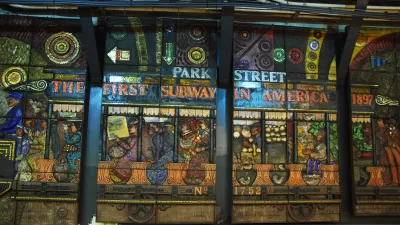Boston commuters report frustrations with a lack of parking at stations along the system—so much so that they sometimes abandon hope of finding a spot or catching a train.
"The struggle to find parking [at MBTA stations] is discouraging some commuters from using public transit," according to an article by Nicole Dunga.
Dunga shares the statistics at the center of the problem: "As of late January, the T owned nearly 49,600 parking spots across the state, compared to the nearly 1.3 million rides it provides on a typical weekday. While it is difficult to know exactly how many parking spaces are needed by commuters, it is clear to some of them that the demand outpaces supply at several stations."
Despite the addition of three new parking structures at stations in the system, parking is still scarce throughout the system and one station, Quincy Center, had to permanently shut its parking garage in 2012 because of structural damage.
Dunga also quotes UCLA Professor Donald Shoup to explain the potential impacts of parking shortages on a transit system. According to Shoup, "[it's] terrible to have a full parking lot determine the success of a transit system and the value of using transit."
Similar parking shortages have been reported at suburban stations of the BART system in the San Francisco Bay Area. A one dollar fee for parking was recently implemented at some stations that had been free since the system opened in 1972.
FULL STORY: Parking struggle discouraging some from using MBTA

Pennsylvania Mall Conversion Bill Passes House
If passed, the bill would promote the adaptive reuse of defunct commercial buildings.

Planning for Accessibility: Proximity is More Important than Mobility
Accessibility-based planning minimizes the distance that people must travel to reach desired services and activities. Measured this way, increased density can provide more total benefits than increased speeds.

World's Largest Wildlife Overpass In the Works in Los Angeles County
Caltrans will soon close half of the 101 Freeway in order to continue construction of the Wallis Annenberg Wildlife Crossing near Agoura Hills in Los Angeles County.

Brightline West Breaks Ground
The high-speed rail line will link Las Vegas and the Los Angeles area.

Colorado Bans No-Fault Evictions
In most cases, landlords must provide a just cause for evicting tenants.

Alaska Village Becomes Test Case for Climate Change Relocation
The Yup’ik village of Newtok is the first Alaska community to begin a full-scale relocation necessitated by the impacts of climate change. Another 31 Alaska communities remain vulnerable.
City of Costa Mesa
Licking County
Barrett Planning Group LLC
HUD's Office of Policy Development and Research
Mpact Transit + Community
HUD's Office of Policy Development and Research
Tufts University, Department of Urban and Environmental Policy & Planning
City of Universal City TX
ULI Northwest Arkansas
Urban Design for Planners 1: Software Tools
This six-course series explores essential urban design concepts using open source software and equips planners with the tools they need to participate fully in the urban design process.
Planning for Universal Design
Learn the tools for implementing Universal Design in planning regulations.


























